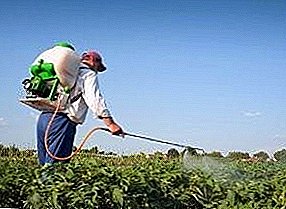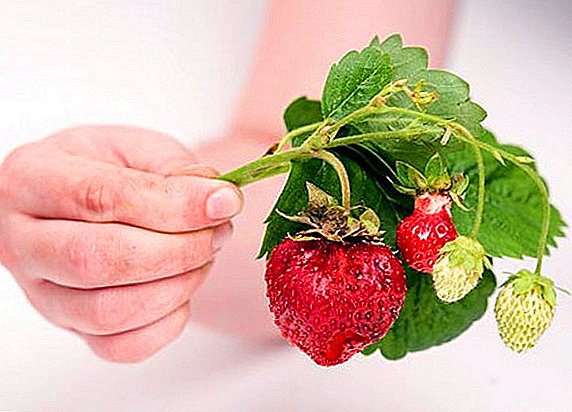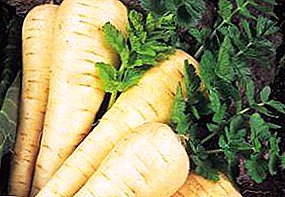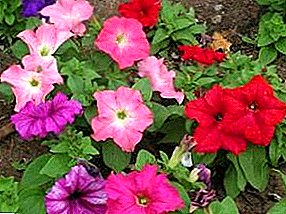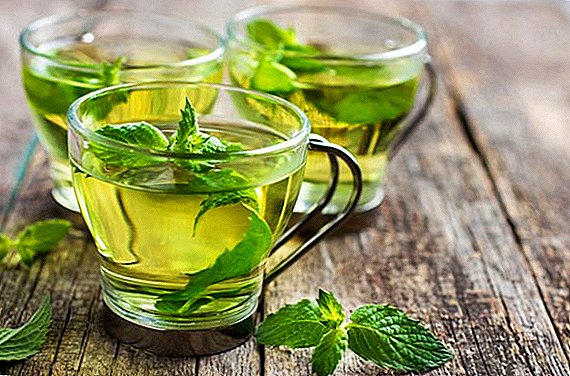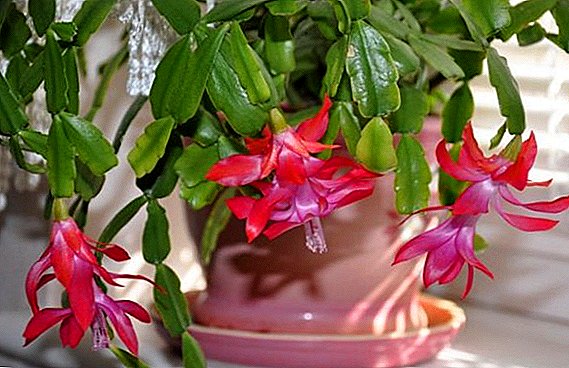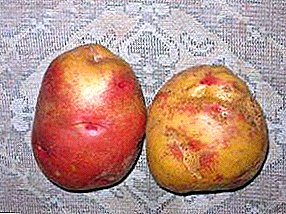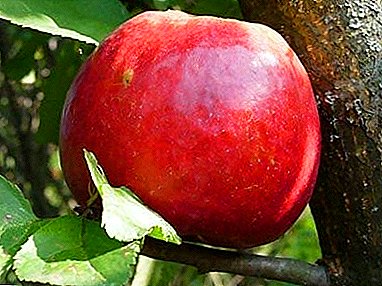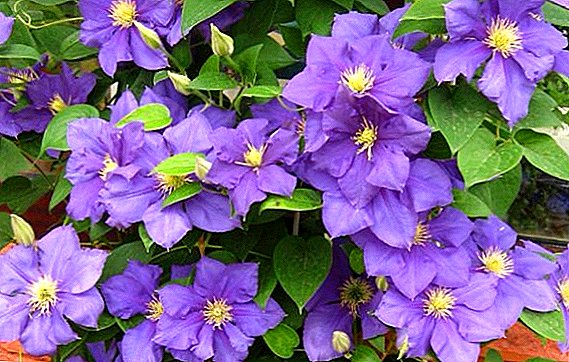 Quite often, planting ornamental plants, you hope that they will bloom and please the eye. But sometimes it happens that the plant starts to hurt. In this case, you will not see any lush flowers or healthy bright leaves.
Quite often, planting ornamental plants, you hope that they will bloom and please the eye. But sometimes it happens that the plant starts to hurt. In this case, you will not see any lush flowers or healthy bright leaves.
This topic is designed to help your clematis, which struck the "disease". We will examine why clematis grows poorly, what to do if the tree is infected with parasites, how to protect the bush from frost and much more.
Did you know? Clematis is registered at the Royal Horticultural Society, which is located in London.
Proper watering and soil care
Since clematis (clematis) is light-requiring, heat-loving, likes moist and fertilized soil, improper care of them can lead to a bad state of the plant or its death.
 Let's start with watering. After planting, the plant must be watered every week in sufficient quantity. If the weather is hot and dry, watering is carried out every 5 days. After adaptation, the plant is watered every 8-9 days. When the ground at a depth of 20 cm near the clematis dry - you need to water the plant.
Let's start with watering. After planting, the plant must be watered every week in sufficient quantity. If the weather is hot and dry, watering is carried out every 5 days. After adaptation, the plant is watered every 8-9 days. When the ground at a depth of 20 cm near the clematis dry - you need to water the plant.
To clematis bloom profusely, the soil must be moistened to a depth of roots (60 cm). This, first of all, refers to the bushes over 5 years old. You can do it this way: in a diameter of 30 cm from the bush, you install containers with a hole in the bottom; after standard watering fill them with water. Thus, the water will gradually seep into the ground and reach the desired depth.
Important! The older the plant, the worse it will bloom. Since every year the roots go more into the ground, it is almost impossible to moisten the ground at a depth of more than 80 cm.
 We turn to the proper care of the soil. After each watering, it is necessary to loosen the soil so that it does not become covered with a solid crust. Since the plant needs a moist and loose earth, laying mulch would be an excellent option. For mulching is used humus sprinkled with peat. This mulch performs several functions at once: it keeps the earth moist, fertilizes the soil, protects the roots from freezing, and provides shelter for beneficial organisms (earthworms).
We turn to the proper care of the soil. After each watering, it is necessary to loosen the soil so that it does not become covered with a solid crust. Since the plant needs a moist and loose earth, laying mulch would be an excellent option. For mulching is used humus sprinkled with peat. This mulch performs several functions at once: it keeps the earth moist, fertilizes the soil, protects the roots from freezing, and provides shelter for beneficial organisms (earthworms).
Why does clematis not grow? Perhaps because, in addition to the mechanical processing of the soil, it is also important to apply fertilizer. Clematis spends a lot of resources on flowering and before the cold drops all overhead vegetative mass. If you do not feed the plant 2 times a month, then it will start to decay very quickly. You need to make about 10 liters of nutrients per adult plant (or 2 small ones).
Important! Small-flowered clematis fertilize 2-3 times per season (3 months).
Consider the lack of important elements, and how it is displayed on the plant.
1. Lack of nitrogen. When clematis lacks this element, its leaves turn yellow and become reddish, the flowers turn out small and discolored. Nitrogen is most needed in the spring plant. For fertilizing use ammonium nitrate (15 g per 10 liters of water) and slurry (1 part per 10 liters of water).
2. Lack of phosphorus. With a lack of phosphorus leaves become brown with a purple tinge. Bring this item in September. For top dressing use superphosphate (20 g per 10 l of water) or bone meal (sprinkle the earth with a calculation of 200 g per 1 sq. M.).
3. Lack of potassium. It leads to darkening and blackening of the peduncle and pedicle, the edges of the leaves become light brown. This can be remedied by adding the following fertilizers: potassium nitrate (used in the spring) or potassium sulfate (at the end of the summer) in a ratio of 25 g per 10 liters of water.
Is pruning done correctly
This section will help you understand the reason why clematis grows poorly. Since this plant dumps almost the entire ground mass for the winter, in the spring it needs to gain it very quickly. In this case, each extra branch or shoot can affect not only the number of flowers and their size, but also whether the bush will bloom at all.
 Proper pruning reduces the load on a herbaceous plant in the spring and relieves the bush from dead and diseased branches. After the first year of growing season, all bushes require a strong pruning. Thus you stimulate the growth of new basal shoots.
Proper pruning reduces the load on a herbaceous plant in the spring and relieves the bush from dead and diseased branches. After the first year of growing season, all bushes require a strong pruning. Thus you stimulate the growth of new basal shoots.
Important! If in the second year of vegetation, clematis does not develop well, then in the fall they repeat the “capital” pruning of the bush.
In subsequent years, pruning is carried out depending on the group of plants:
- Early flowering. After flowering, faded shoots are cut, sick and weak.
- Early summer blooming. This group includes clematis hybrids that re-bloom in August / September. Pruning is carried out in late autumn (cut off sick, dry shoots). Also spend sparing pruning last year's shoots by 2 mm.
- Late flowering Clematis that bloom in summer and autumn. In this case, a strong pruning is carried out (leaving 20 cm from the ground level). Flowers next year will appear on the new shoots.
It is important to adhere to the technique of pruning, so as not to damage the plant: you need to cut clematis with a sharp shear just above the bud.
Important! After pruning each bush requires disinfection secateurs.
Is winter protection reliable?
How to protect the plant from frost and hypothermia? Many gardeners have difficulty hibernating this plant. Clematis can freeze and die, or it will bloom badly.
 There are several options for covering clematis for the winter:
There are several options for covering clematis for the winter:
- dry;
- air;
- combined.
Air shelter mode. Shoots for the winter are covered with a film (set the frame and stretch the film). If the winter is snowless and warm, the plant can simply perepret.
Combined method. First, sprinkle with sawdust, and then build a frame over the plant and stretch the film. This method will be the most optimal, since the roots will be protected from frost, and the film will not miss the excess moisture.
Clematis Pest Control
The plant is not protected from pests that in one season can simply destroy your bush. Pests cause significant damage to it: they damage the buds, buds, leaves and suffer dangerous diseases. Consider the most dangerous pests of clematis.
Nematodes
They are small worms (up to 1 mm), which parasitize on leaves, roots and shoots. Nematodes slow the growth and development of clematis, and with strong invasion it can die.
Important! The most dangerous for the plant is the root gall nematode.
It is impossible to get rid of nematodes, therefore the plant is subject to destruction, and the soil is disinfection (with hot steam for 14 hours).
Spider mite
 This pest winters under the leaves and in the cracks of the ground. The mite infects the foliage of the plant, which begins to twist and fall. To combat use infusion of garlic (200 crushed onions per 10 liters of water).
This pest winters under the leaves and in the cracks of the ground. The mite infects the foliage of the plant, which begins to twist and fall. To combat use infusion of garlic (200 crushed onions per 10 liters of water).
Beet aphid
This parasite feeds on plant sap, lives on leaves and sprouts. To get rid of it, the drug "Antitlin" or common wood ash is used, which needs to treat the affected areas of the plant.
Shchitovka
Like aphids, they feed on plant sap. For the destruction of scutes, use 40% ethyl alcohol, which is washed plants every 10 days. Other pests (slugs and rodents) are destroyed by standard drugs or mechanical removal.
The main types of clematis diseases
Clematis has one feature - a well-developed root system, which goes deep into the ground. Most often because of this, these plants can die from various diseases. In this section, we will look at a few of the ailments of this plant, find out why clematis does not bloom, and how to solve this problem.
Did you know? Clematis is used in medicine as a medicine for relieving stress and calming down.
Leaf Rust
 Clematis rust is the appearance of orange pads on shoots, petioles and leaves. The disease manifests itself in spring. When the disease spreads, the leaves of the plant wither and the shoots twist and become crooked.
Clematis rust is the appearance of orange pads on shoots, petioles and leaves. The disease manifests itself in spring. When the disease spreads, the leaves of the plant wither and the shoots twist and become crooked.
The virus of this disease is a fungus that overwinters on the shoots and infects the growing shoots in the spring. If the leaves and shoots damaged by rust are not removed in time, clematis will develop poorly and may die. Rust on the leaves weakens the plant and adversely affects its wintering.
For prevention, we advise you to remove the weeds, on which the pathogen most often winters. If it was not possible to protect the plant from rust, then at the first signs it should remove the damaged leaves and shoots, and then spray clematis with Bordeaux liquid.
Leaf spot
 Septoria (or leaf spot) is a common disease among plants. Did not bypass this "disease" and clematis. The causative agent of this disease is the fungus Septor.
Septoria (or leaf spot) is a common disease among plants. Did not bypass this "disease" and clematis. The causative agent of this disease is the fungus Septor.
This disease is characterized by the fact that many small round brown-colored spots appear on the upper leaf blades. The size of these spots - 2-5 mm. Along the edges they are black. A little later, the affected area brightens, but the black bezel remains. If black dots appear on the bright spot, you should know - these are the fruit bodies of the fungus Septor along with the spores. These disputes spread throughout the bush. The affected leaves turn yellow and, dying off, fall down.
The plant remains without leaves, as a result of which physiological processes are disturbed.. The affected plant practically does not bloom, is deprived of immunity and susceptible to other fungal diseases.
 If the fungus spreads, the spots appear on the leaf petioles and on the new shoots, the young bark dies off, and the tip dries out. The black fruiting bodies of the fungus pass into the wintering stage and survive the winter perfectly on the fallen leaves and bark. The spread of this disease contributes to cold and wet weather.
If the fungus spreads, the spots appear on the leaf petioles and on the new shoots, the young bark dies off, and the tip dries out. The black fruiting bodies of the fungus pass into the wintering stage and survive the winter perfectly on the fallen leaves and bark. The spread of this disease contributes to cold and wet weather.
In order to avoid infection with the fungus (Septoriozom), you need to collect and dispose of fallen leaves, and then process the cuts with garden pitch. If clematis grows in greenhouses, then it is necessary to reduce the humidity of the air and increase the irradiation of plants with sunlight.
Mealy dew
This disease is caused by phytopathogenic erizif fungi.
 The first symptom of powdery mildew is white blotch on clematis. Young leaves, buds, flowers and shoots are affected. Plaque can also be on the stems and leaves of the plant.
The first symptom of powdery mildew is white blotch on clematis. Young leaves, buds, flowers and shoots are affected. Plaque can also be on the stems and leaves of the plant.
After the raid, the first brown spots appear, the leaves and shoots dry out and deform. Clematis is affected by this disease most often in July and August. Promotes the spread of fungus hot weather. If clematis fell ill with powdery mildew, all parts of the shrub should be cut and disposed of as soon as possible.
Important! You can not leave infected branches at the site, otherwise the disease will return.
Fusarium
 The most dangerous disease of all those listed is fusarium.
The most dangerous disease of all those listed is fusarium.
Clematis suffer from fungal wilt, which is called fusarium. This disease penetrates through damaged and weakened tissues. The mushroom clogs the conductive "vessels", and the metabolism of useful substances is disturbed. Fusarium wilt is observed in species of plants with large flowers. Under the threat and young plants. The mushroom grows in the shoots damaged at the base. The lesions wither, the leaves turn brown at the edges. High temperature + 20 ... + 30 ° C contributes to this. Signs of this disease appear in the second half of June.
For prevention should choose the right landing sites. The fungus develops on flowers that grow in excessively moist areas.
Measures to combat this disease:
- prune all shoots at the base of the bush;
- collect all fallen leaves and dispose off site;
- sanitize the diseased plant.
Gray rot on clematis leaves
 This disease affects flowers in rainy time. Over time, brown spots appear on the leaves, as well as gray fluffy patina.
This disease affects flowers in rainy time. Over time, brown spots appear on the leaves, as well as gray fluffy patina.
This disease is caused by a fungus called botritis. The main symptom of this disease - the appearance of a raid on the stem and leaf stalks. If the plant is affected by a fungus, then it begins to rot, and then completely dies.
To protect your flowers from the fungus, you should avoid stagnant water in the ground and on the leaves.
Unfortunately, there is no reliable cure for the disease. If the gray rot has spread to the plant, then the bush will have to be destroyed so that the fungus does not spread.
To prevent the disease from infecting clematis, you need to fertilize the plant with nitrogen fertilizer, it should be watered next to the root of the bush. Spray the shrub with a 0.2% solution of basezol.
Thus, if you deal with pests on time, prune at the right moment and apply fertilizer to the soil, the plant will feel great, please you with luxurious flowers and healthy leaves.


